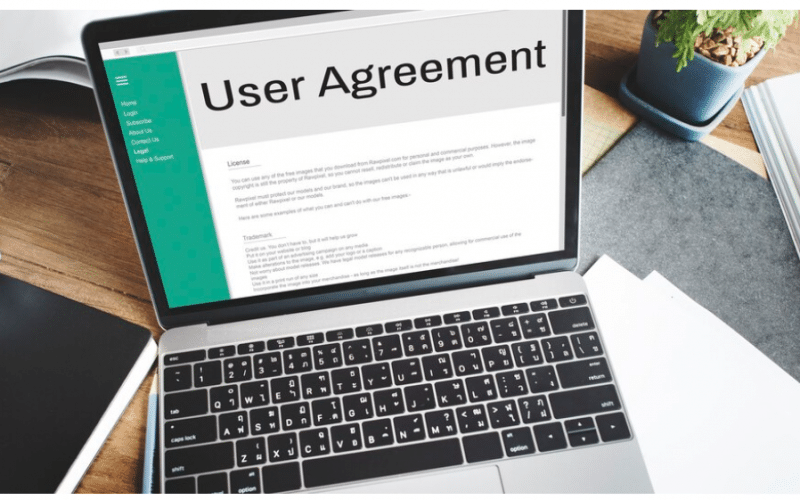What Is End User License Agreement?
EULA, or End User License Agreement, is a legally binding contract between a product owner and end-user, defining software rights and restrictions. It is typically presented during the installation or set-up stages and is only valid if agreed upon.
The End User License Agreement (EULA) typically involves two parties:
- The Software Provider/Author/Licensor is the party that grants the license for the software, often a company or individual.
- The End-user, buyer, or licensee is the individual or organization receiving the license and agreeing to comply with the EULA terms and conditions. Additionally, the end-user can be a personal user or a business or organization installing the software for employees or members.
Other Names for an End-User License Agreement
Various names for the end-user license agreement exist, including:
- EULA.
- Licensed application end-user agreement.
- Software license agreement.
- Licensing agreement.
- Software license agreement.
- Click-wrap license.
- Shrink-wrap license.
- Browse-wrap license.
What Is The Purpose Of An End-User License Agreement?
EULAs protect software creators’ and inventors’ rights, including copyright, but do not protect consumers. Buyers have a license to use the software, but they do not own the software or have legal ownership rights. Additionally, they cannot sell or transfer the software to third parties. Similar to a rental agreement, the purchaser has the license to use the software but retains ownership rights.
Components of an End-User Licensing Agreement
Although a licensing agreement will differ from one product to the next, it should always have some fundamental elements, such as:
#1. Licensor
This includes the name, address, and other contact information of the person who developed the software.
#2. Warranty Disclaimer
explains that the supplier is not liable for any issues that arise as a result of the program and that it is given “as is”.
#3. Infringement acknowledgment
This declares that the licensee is responsible for any copyright violations.
#4. Governing law
This list lists the state laws that take precedence in the event of a dispute.
#5. Licensee
This contains the user’s name, address, and other contact information for the individual making the product use request.
#6. License granting
This authorizes the licensee to utilize the software.
#7. Software
Gives the name of the program that is receiving a license.
#8. Maintenance and support
This indicates whether the app will be supported and maintained and whether it will be done so via phone, email, or in person. Additionally, it also specifies the frequency and timing of maintenance.
#9. Start date
This specifies when the end user becomes subject to the terms and conditions. They might be bound by the terms, for instance, when they download something or open a package.
#10. User Restrictions
User restrictions restrict how the application may be legally used by the end user.
#11. Site licenses
This specifies whether a user may install the program on multiple devices.
#12. Termination
This specifies which contraventions give the software vendor the authority to terminate the contract.
Should I Agree To End-User License Agreement?
Yes, if you must pay for the program or software, then you must agree to the EULA before making the purchase. Therefore, licensing agreements are sometimes used by businesses to protect their reputation.
How Do I Create An End-User License Agreement?
When drafting an EULA, remember to include the following:
#1. Parties
Describe your company and yourself. Use your company’s full legal name so that end users will know with whom they are concluding a transaction. Additionally, you must make it clear that this contract is an EULA and that it is between you and the end user.
#2. Grant of license
This is declares that the end user has been granted permission to use the program. The most crucial section of an EULA is this one, so write it as plainly as you can.
#3. Limitations on use
This establishes what end users can and cannot do with your product is the next step. Note that the majority of EULAs restrict end users from using the software strictly for personal use. However, certain EULAs, like those for software for design and illustration, allow customers to use the program for profit.
In any case, most or all EULAs forbid users from taking the following actions without first receiving your company’s explicit consent:
- Copying the program to create, market, produce, or create third-party hardware or software
- Utilizing the program to support illicit behavior, such as hacking
- Letting a third party use the app
- Rebranding the app after it has been translated into a new product
- Decompiling the software, either in full or in part
#4. Termination conditions
The end user must be aware that if they violate the EULA, they have the right to stop the agreement at any moment. Additionally, they should also be aware that they can end the arrangement at any time.
#5. Warranties and disclaimers
To ensure smooth application functionality, the use of warranties and disclaimers urges end-users to use the product “as is” and control expectations, avoiding assertions or promises beyond legal standards.
#6. Limitation of liability
If an end user’s property or reputation is harmed as a result of using your application, this clause will reduce your culpability.
You should specify that you won’t be liable for any incidental, or consequential damages brought on by the application’s malfunction, usage, or possession, such as:
- Loss of reputation and goodwill in the business
- Injury to the person (up to a point)
- Hardware failure
- Damage to property
- Punitive consequences resulting from any claims relating to this EULA, whether based on tort, strict liability, a contract, or something else entirely.
#7. Jurisdiction
EULA laws govern businesses in their main business country, sometimes including other jurisdictions. However, End-users from EU member states can raise proceedings in their home countries.
#8. Contact information
Finally, you must provide users with information on how to get in touch with you if they have any questions or issues with your EULA. One contact method, like a phone number or email address, is all that is required; more methods can be added as necessary.
What Is Huawei’s End-User License Agreement?
The Huawei Cloud End User License Agreement governs the access and use of Huawei Cloud services provided by authorized Solution Providers or Resellers. Furthermore, the agreement is entered into between Huawei Cloud’s Contracting Party and the entity representing the end user or individual.
Is It Safe To Accept The Eula?
Before accepting an End-User License Agreement (EULA), it’s crucial to read the agreement thoroughly to understand the rights, obligations, privacy, data security, intellectual property rights, limitations on use, and potential risks or liabilities. Additionally, you should evaluate the agreement’s privacy and data security, intellectual property rights, limitations and liabilities, transparency and fairness, and legal jurisdiction, and seek legal advice if necessary.
Furthermore, EULAs are legally binding agreements, and accepting them indicates an agreement to abide by the terms and conditions. Therefore, if you have reservations or concerns, you may choose not to accept the EULA and seek alternative software or service options.
Do I Have To Accept the Microsoft License Agreement?
The license terms are an agreement between Microsoft Corporation and you, governing the use of the software and any subsequent versions. By using the software, you accept these terms; if not, do not use it. These terms include the software’s installation and use rights, including home use, small business use restrictions, and the inclusion of other Microsoft programs.
Furthermore, home users can install copies on personal devices, while small businesses can use up to ten devices. The software’s components are licensed as a single unit, and the license terms apply to the use of these programs.
Can I Bypass The End User License Agreement?
Bypassing an End-User License Agreement (EULA) is generally not recommended as it may violate the contract, lead to legal consequences, lack of updates and support, and pose security risks. Therefore, it’s crucial to read and understand the terms before accepting the agreement. However, if disagreements arise, consider alternative software or service options.
What Is The Difference Between End-User License Agreement And License Agreement?
EULAs and License Agreements are interchangeable terms for contracts between licensors and licensees, referring to the contract between the licensor and licensee. EULAs are specific to software and digital goods, while License Agreements cover a broader range of products, services, or intellectual property, such as patents, trademarks, and copyrights. Both terms are used when the licensee is another business or entity, rather than the end consumer.
CHARTERED FINANCIAL ANALYST: Definition, Requirement, Salary, License & How to Get One
SOCIAL WORK: Definition, Salary, Degree, Master & License
Microsoft Volume License: Everything You Need to Know 2023





